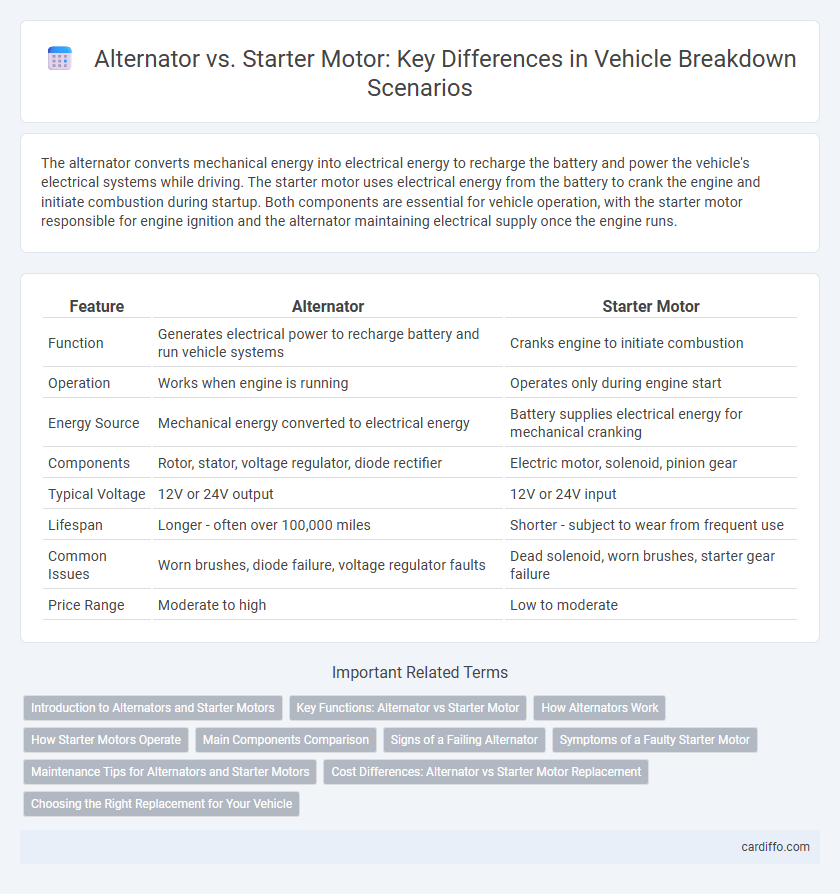The alternator converts mechanical energy into electrical energy to recharge the battery and power the vehicle's electrical systems while driving. The starter motor uses electrical energy from the battery to crank the engine and initiate combustion during startup. Both components are essential for vehicle operation, with the starter motor responsible for engine ignition and the alternator maintaining electrical supply once the engine runs.
Table of Comparison
| Feature | Alternator | Starter Motor |
|---|---|---|
| Function | Generates electrical power to recharge battery and run vehicle systems | Cranks engine to initiate combustion |
| Operation | Works when engine is running | Operates only during engine start |
| Energy Source | Mechanical energy converted to electrical energy | Battery supplies electrical energy for mechanical cranking |
| Components | Rotor, stator, voltage regulator, diode rectifier | Electric motor, solenoid, pinion gear |
| Typical Voltage | 12V or 24V output | 12V or 24V input |
| Lifespan | Longer - often over 100,000 miles | Shorter - subject to wear from frequent use |
| Common Issues | Worn brushes, diode failure, voltage regulator faults | Dead solenoid, worn brushes, starter gear failure |
| Price Range | Moderate to high | Low to moderate |
Introduction to Alternators and Starter Motors
Alternators convert mechanical energy into electrical energy to recharge a vehicle's battery and power the electrical system while the engine runs. Starter motors use electrical energy from the battery to initiate engine combustion by turning the engine crankshaft. Both components are essential for vehicle operation, with the alternator maintaining electrical supply and the starter motor enabling engine startup.
Key Functions: Alternator vs Starter Motor
The alternator generates electrical power to recharge the battery and supply energy to the vehicle's electrical systems while the engine runs. The starter motor uses electrical energy from the battery to crank the engine and initiate the combustion process during startup. Both components are critical for vehicle operation, with the starter motor enabling engine ignition and the alternator sustaining electrical functionality.
How Alternators Work
Alternators generate electrical power by converting mechanical energy from the engine's rotation into alternating current using a rotating magnetic field and a stator of wire coils. This AC is then converted to direct current by diodes to charge the vehicle's battery and power electrical systems while the engine runs. Unlike the starter motor that uses battery power to crank the engine, the alternator sustains the electrical system once the engine is operational.
How Starter Motors Operate
Starter motors operate by converting electrical energy from the vehicle's battery into mechanical energy to initiate engine combustion. When the ignition key is turned, an electric current flows to the starter solenoid, which engages the starter gear with the engine's flywheel, enabling the engine to crank and start. This mechanism is crucial for engine ignition, distinguishing starter motors from alternators that recharge the battery and supply power once the engine is running.
Main Components Comparison
The alternator consists of key components such as a rotor, stator, diode rectifier, voltage regulator, and cooling fan, all designed to generate and regulate electrical power while the engine runs. In contrast, the starter motor primarily includes an armature, commutator, brushes, drive pinion, and solenoid, which work together to convert electrical energy from the battery into mechanical motion to crank the engine. Both components rely on electromagnetic principles, but the alternator focuses on power generation and battery charging, whereas the starter motor is dedicated to initiating engine startup.
Signs of a Failing Alternator
Dimming headlights, especially when idling, often indicate a failing alternator as it struggles to supply consistent electrical power. Unusual whining or grinding noises from the engine bay can signal worn alternator bearings or internal components. Frequent battery warning lights on the dashboard explicitly suggest alternator malfunction, leading to insufficient battery charging and potential car breakdowns.
Symptoms of a Faulty Starter Motor
A faulty starter motor often causes symptoms such as a clicking noise when turning the key, engine failure to crank despite a fully charged battery, and intermittent starting issues. Dim dashboard lights or no response when attempting to start can also indicate starter motor problems rather than alternator failure. Identifying these symptoms promptly prevents breakdowns and ensures reliable vehicle ignition.
Maintenance Tips for Alternators and Starter Motors
Regular inspection of alternators and starter motors is critical to prevent vehicle breakdowns by ensuring electrical components function properly. Clean terminals and connections, monitor belt tension on alternators, and test starter motor performance to detect early signs of wear or corrosion. Using manufacturer-recommended lubricants and replacing worn brushes or bearings can extend the lifespan of both alternators and starter motors.
Cost Differences: Alternator vs Starter Motor Replacement
Replacing an alternator typically costs between $300 and $700, with parts and labor influencing the price, while starter motor replacement generally ranges from $200 to $500. Alternators tend to be more expensive due to their complex design and critical role in charging the vehicle's battery, whereas starter motors are simpler and less costly to manufacture and install. Cost differences also reflect brand, vehicle model, and mechanic rates, making accurate diagnosis crucial to avoid unnecessary expenses.
Choosing the Right Replacement for Your Vehicle
Selecting the right replacement for your vehicle requires understanding the functions of both the alternator and starter motor; the alternator maintains battery charge and powers electrical systems while driving, whereas the starter motor initiates engine combustion. Diagnose the issue precisely by checking for symptoms such as dimming lights or battery drain indicating alternator failure, versus clicking sounds or engine not cranking pointing to starter motor problems. Opt for OEM or high-quality aftermarket parts matching your vehicle's specifications to ensure optimal performance and longevity.
Alternator vs starter motor Infographic

 cardiffo.com
cardiffo.com